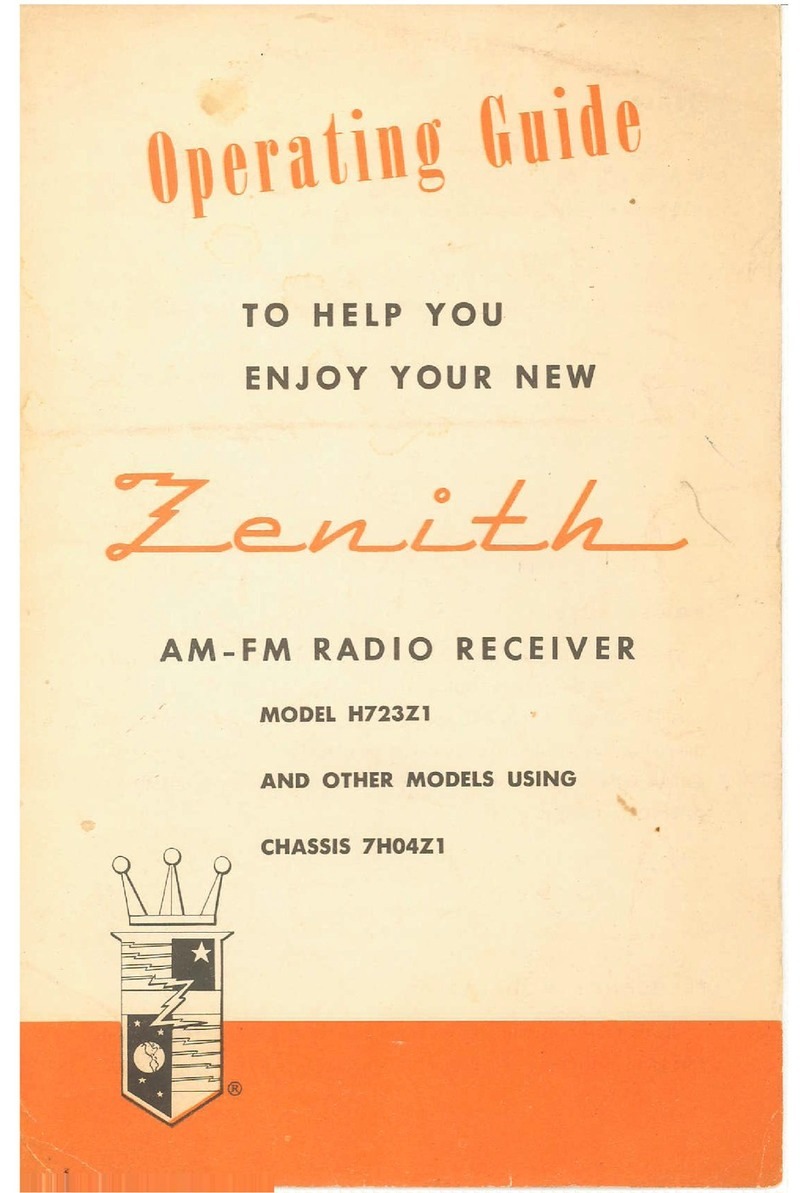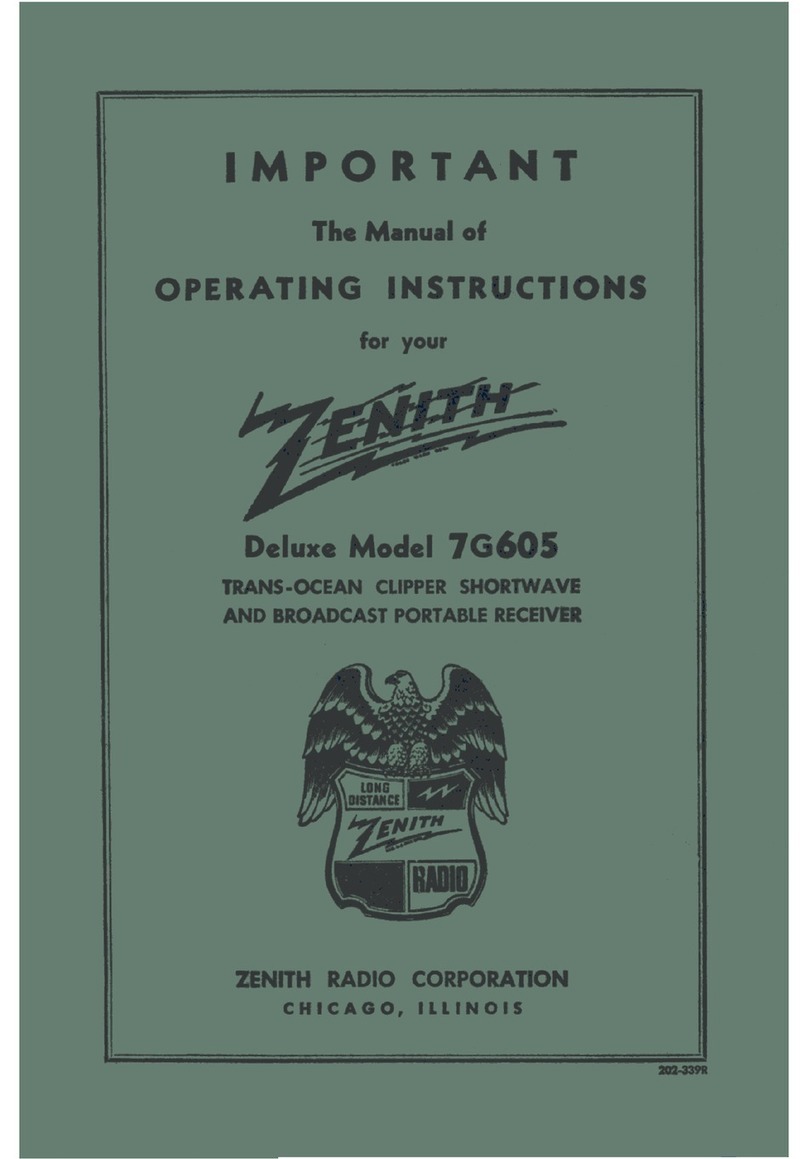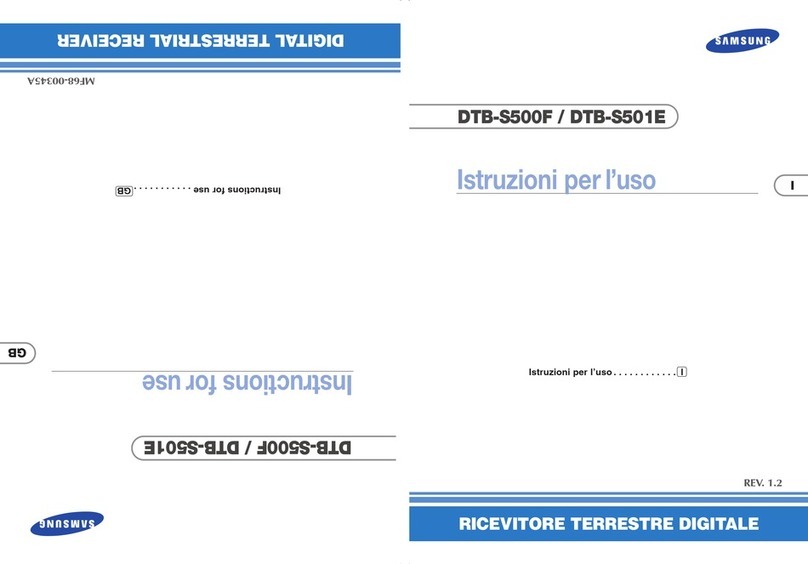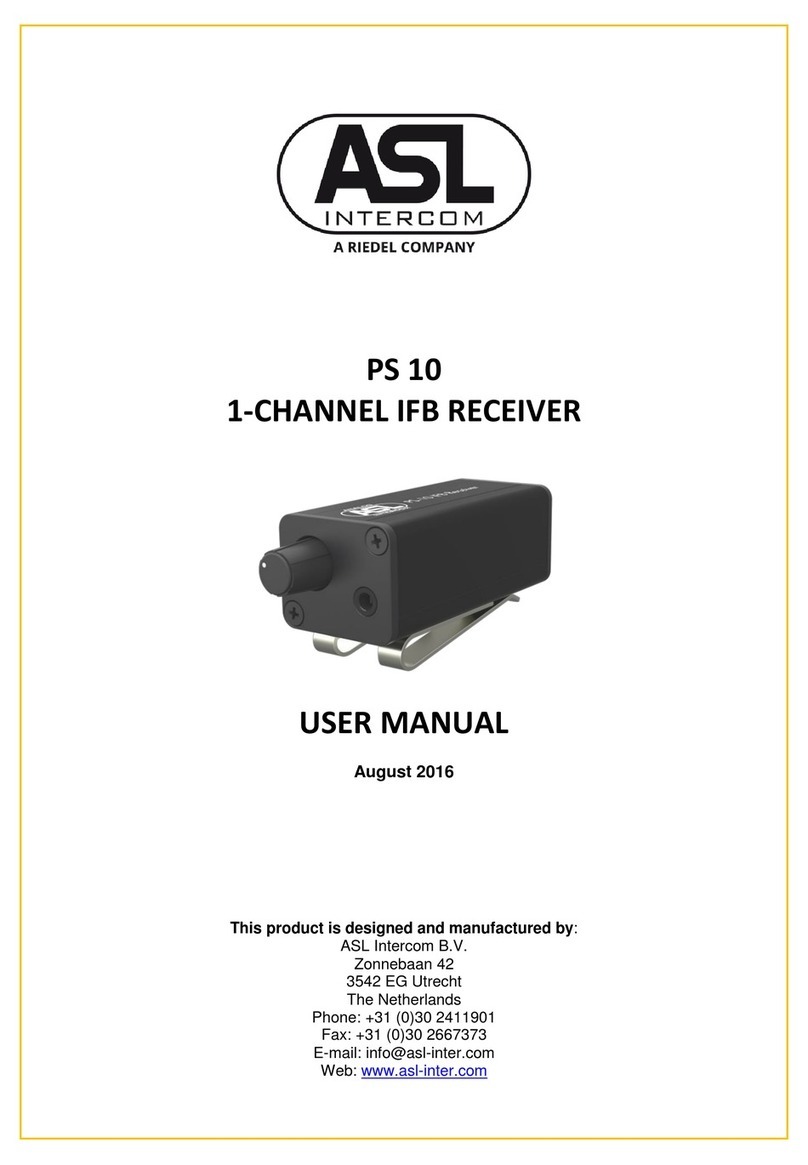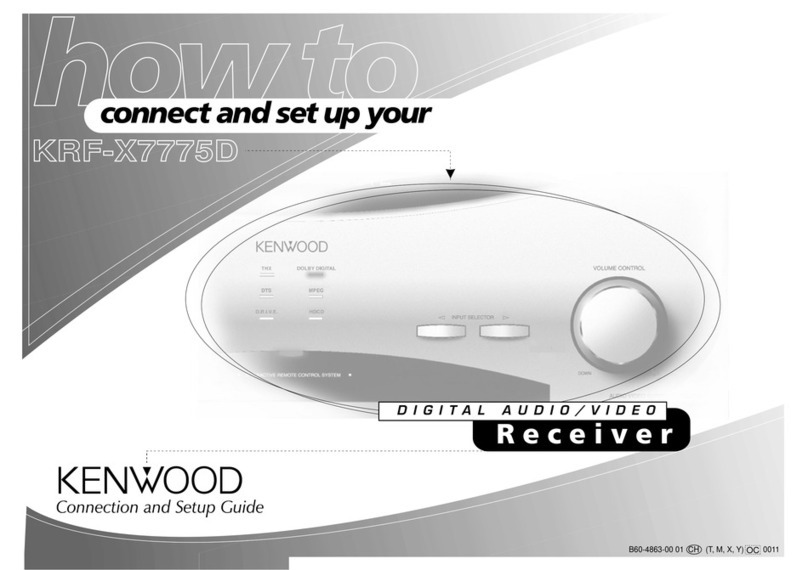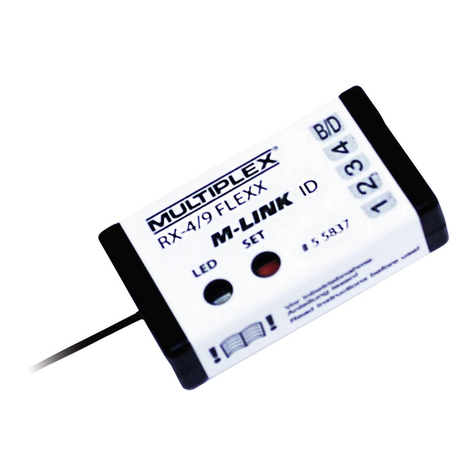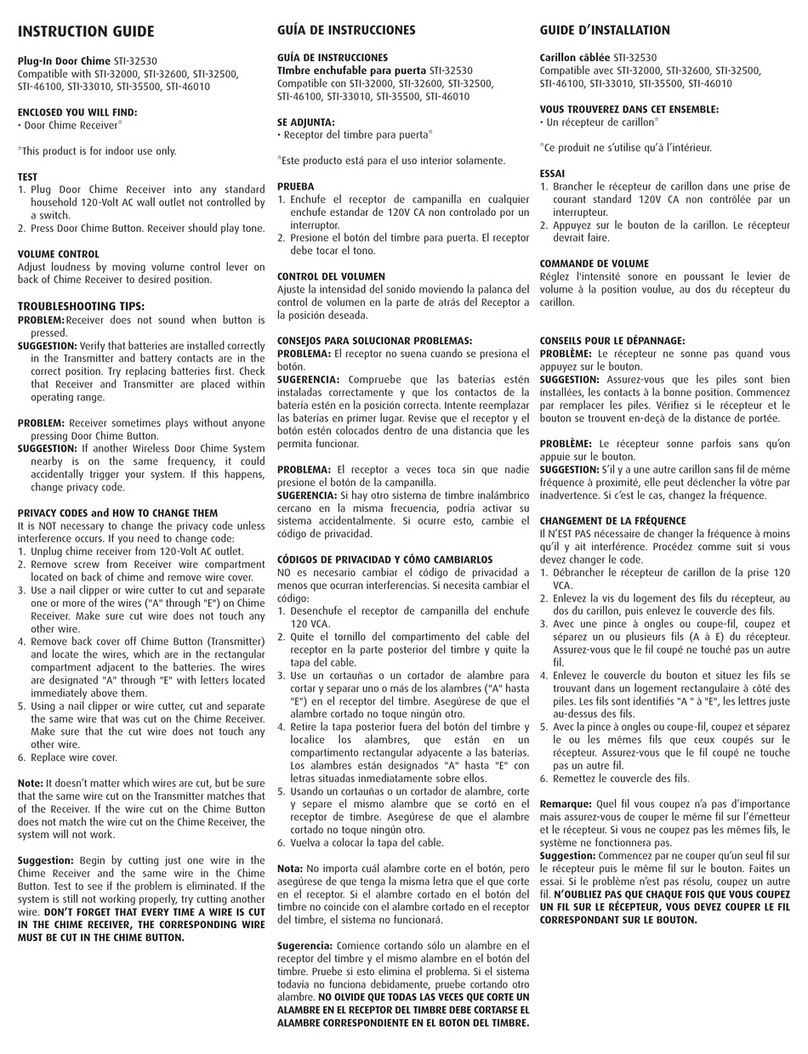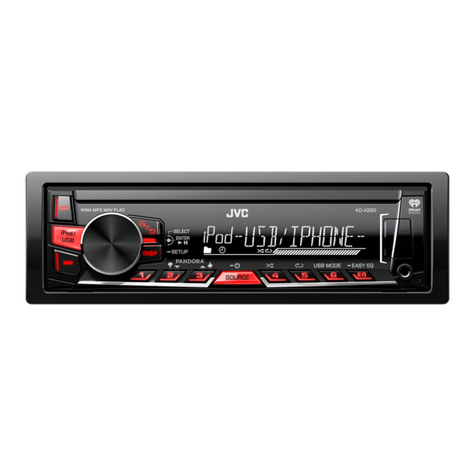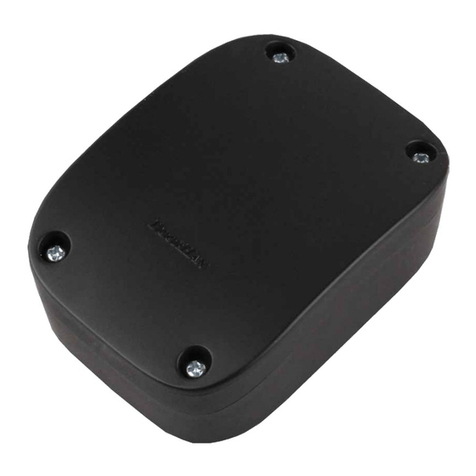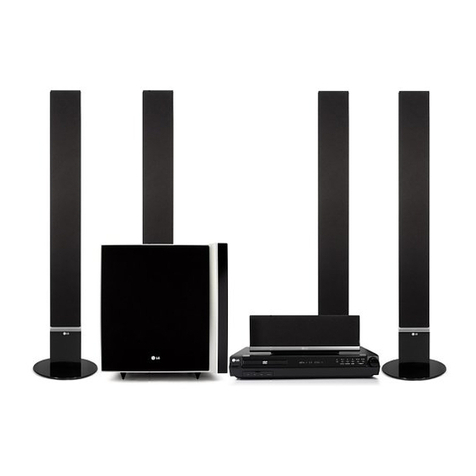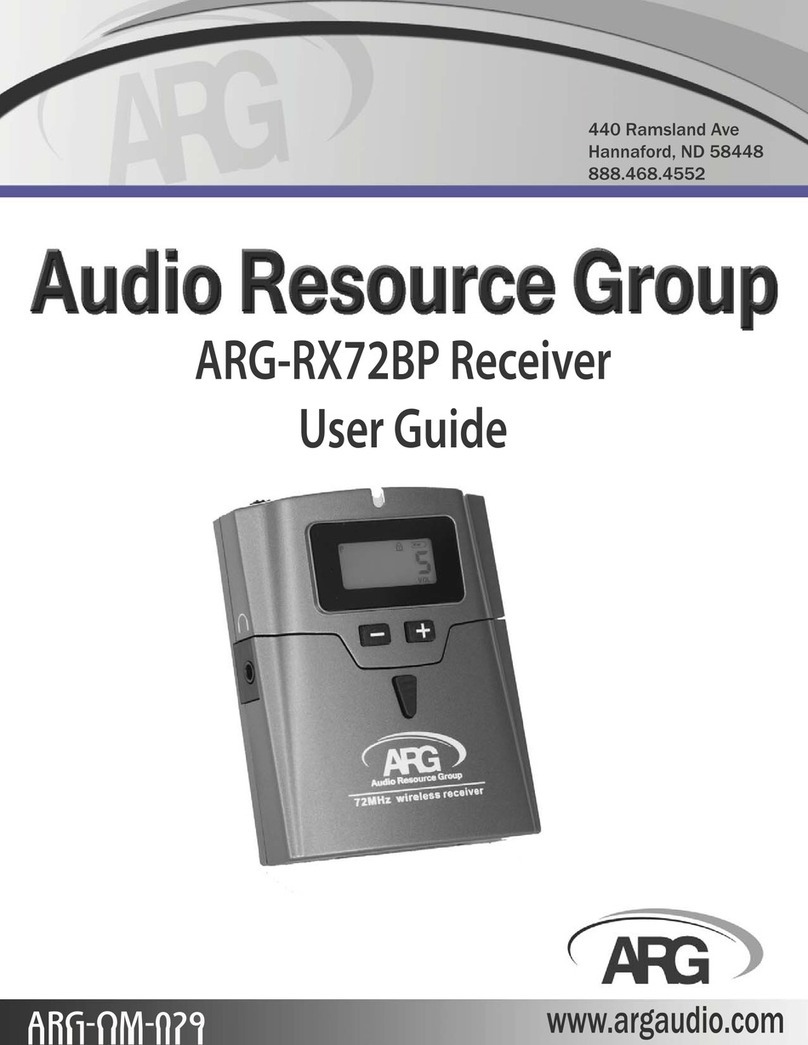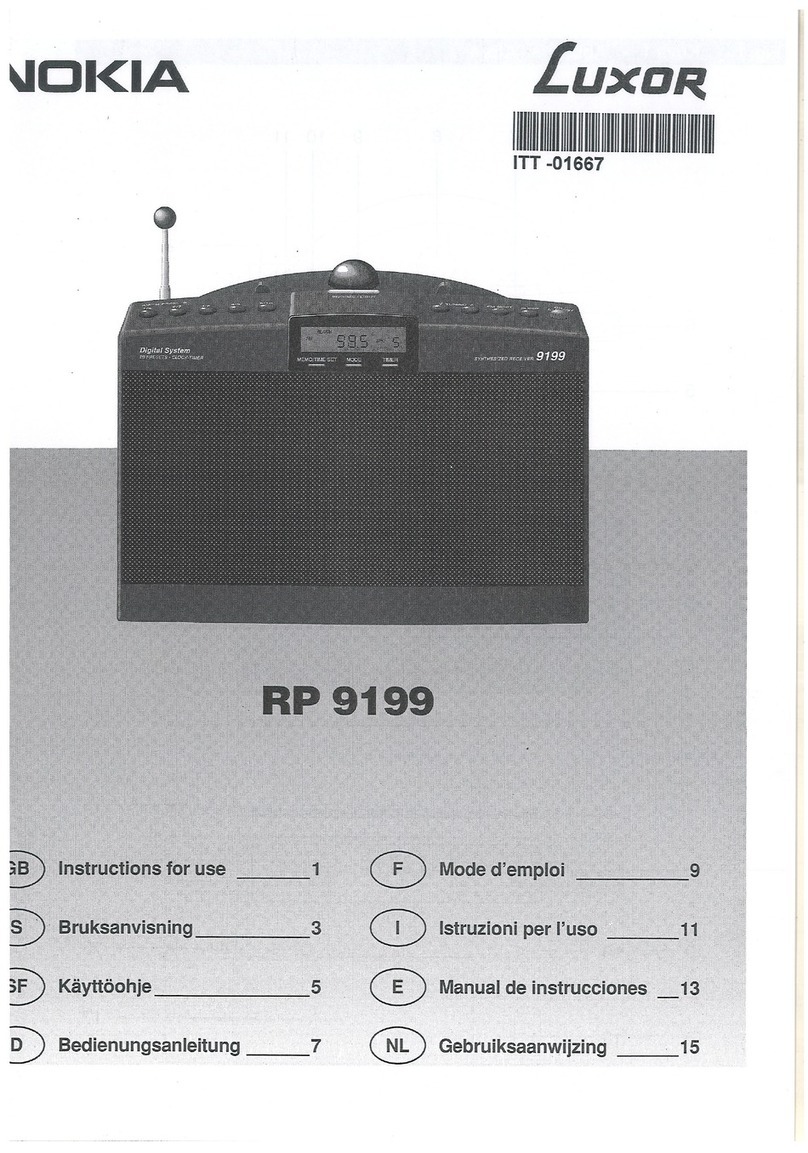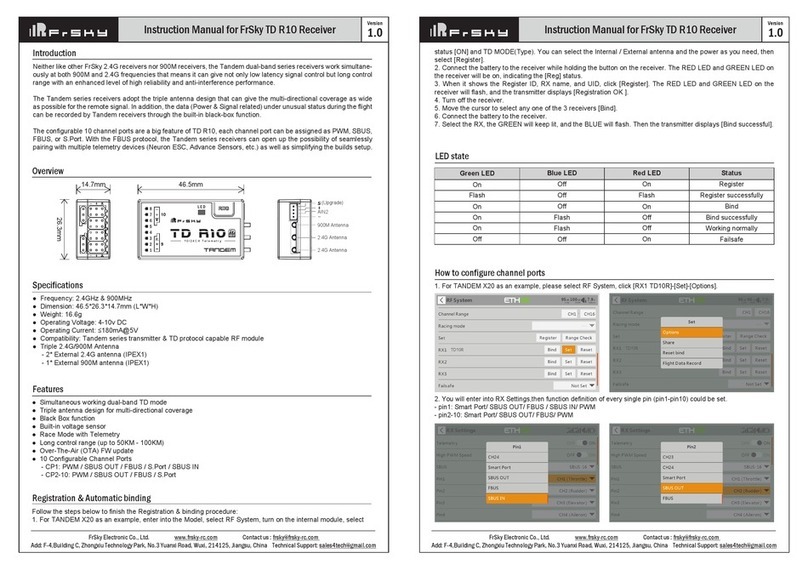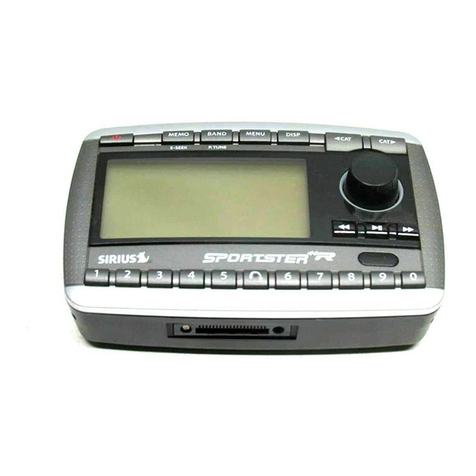Zenith TRANS-OCEANIC H500 User manual


TRANS-OCEANIC
PORTABLE

There Is aWorld of Entertainment and Pleasure
In Your New Zenith Portable
Your Zenith Super Trans-Oceanic portable will operate on battery or
110 Volt AC-DC current. It uses aselenium rectifier and is a5tube
superheterodyne radio, covering the standard broadcast, foreign domes-
tic shortwave bands, and has continuous short-wave coverage from 2to
8megacycles (38 to 150 meters) .It has seven tuned circuits, and a3sec-
tion tuning condenser with atuned radio frequency stage insuring maxi-
mum sensitivity and selectivity. Freedom from blasting on powerful
stations is assured by anew automatic volume control circuit which
controls 3tubes on the broadcast band, ADeluxe Alnico 5, rubber
mounted, permanent magnet, speaker in conjunction with an improved
audio system provides finer tone than ever before.
The four button "RADIORGAN'' tone control permits selection
of 16 different tone combinations. The built in removable WAVE-
MAGNET provides reception in trains, planes, automobiles, boats,
and steel constructed buildings. This standard Wavemagnet is located
on the inside of the front cover and aspecial extension cable is provided
for its use on windows of automobiles, planes, trains, etc. To bring
in shortwave stations with greatly added volume turning the knob on
the top right hand corner of the cabinet allows aWAVEROD Antenna
to snap up, which, when fully extended, provides increased pick up for
shortwave reception.
Two terminals have been provided at the left rear of the chassis
marked "A" and for external antenna and ground connections.
These are for use in areas of extremely low signal strength. By merely
connecting an external antenna and ground to these terminals, signals
previously impossible to obtain are in many cases received with the
volume and clarity of local broadcasts. This external antenna and ground
is ay(omatically connected to the proper standard or shortwave circuit
when the operator presses the band selector buttons.
The band selector buttons on the front panel provide an easy
means of selecting the standard broadcast (BC) or the shortwave band
most suitable to the time of day. Each shortwave band is electrically
SPREAD, which means that stations are separated from each other to a

degree permitting great ease of tuning. Acalibrated second scale has
been incorporated in the top edge of the dial face. It permits short-
wave stations to be accurately logged and easily relocated.
All parts are fully treated against moisture, temperature, and
other climatic conditions. Variations in the performance of the receiver
because of seasonal or geographic changes are held to a minimum,
and the receiver will operate at its maximum efficiency throughout
the world Power consumption on the electric light line is 10 watts.
When the receiver is to be used in areas outside of continental
U. S. A. where 110 volts AC/DC is usually not available, ballast adaptor
No. S-15715 must be used. This ballast adaptor reduces 220 volts AC or
220 volts DC to 110 volts AC or 110 volts DC necessary for proper
operation of the receiver.
READ CAREFULLY —KNOW YOUR ZENITH
PLUG
SPARE T1J8E HOLDER
W&TftUCTJON
BOOK t"XT£lS5iON CORD
POWER PLUS
power com?
DRY &ATTLRY
PACK
BATTERY PACK
SODKfiT
SUCTION CUPS
Figure I. —Rear View, Back Cover Open.
1. PREPARING THE RECEIVER FOR OPERATION
A. OPEN REAR DOOR OF CASE by simply pulling on finger grip
provided.
B. Place the battery pack into the compartment provided below the

receiver chassis and insert battery cable plug into receptacle pro-
vided for on battery. When making replacement of the battery
pack be positive to use only Zenith built Z985 battery pack.
2. BATTERY OPERATION
A, INSERT LINE CORD PLUG into the Battery Saver Switch socket
on top rear of chassis. (See Figure 2.)
Figure 2.—Insertion of Line Cord Plug Into Battery Saver Socket.
B. Turn the receiver ON by rotating the left control knob clockwise.
When not in use, always make certain that power is off by turning
the left control knob fully counter clockwise, until aclick is heard.
C. Proceed as instructed under paragraphs 10, 11, 12, and 13.
D. If used an average of 3to 4hours aday—30 hours aweek, the
battery will give approximately 150 hours of service.
3. LIGHT SOCKET OPERATION
(110-1 25 Volts DC or AC —25 to 60 cycle operation.)
A. Remove the line cord plug from CHANGE OVER socket. Removal
of this plug automatically trips the Battery Saver Switch and pre-
vents battery drain while operating off light socket operation.
B. Plug the line cord into any convenient light socket. After the
receiver is in operation try reversing the plug for minimum hum
or noise when operating on alternating current.
C. On direct current reverse the plug if the set does not operate

after having been turned ON. On DIRECT CURRENT the set
will operate ONLY with the plug in one position.
Supply Voltage Switch
This receiver is equipped with asupply voltage switch, which is at
the right rear corner of the chassis.
SEE INSTRUCTION
BOOK
§1He®
o
if)
o
>
Figure 3.
This supply voltage switch is preset by the factory at 117 volts.
If you are in an area where the supply voltage is lower than 110
volts; loosen the holding screw and slide the switch to expose the
105 volt stamping, refasten holding screw.
WARNING —Do not move line voltage switch from 117
volt position unless you are certain the supply voltage is below
110 volts. Operating the receiver under high supply voltage condi-
tions with the switch in 105 volt position can burn out the tubes
or materially shorten their life.
It is possible that the supply voltage can change throughout
the day since more electricity is usually being used during the
early evening hours when the demand is greatest. If the supply
voltage switch has been set in 105 volt position for the evening
hours of low voltage, the supply voltage may exceed 110 volts dur-
ing the hours of small demand. If this situation occurs, the supply
voltage switch must then be moved to 117 volt position.

220-240 Volts DC or AC —25 to 60 cycle operation.
E. If the receiver is to be used in locations where acurrent supply of
220-240 Volts AC or DC is available, ballast adaptor S15715
should be used. This ballast adaptor assembly can be obtained from
your local Zenith distributor and need only be plugged into the
ballast tube socket. (See Figure 4.)
Figure 4.—Ballast Adaptor Inserted in Socket.
1. Loosen the screw holding the switch positioning plate.
2. Move the switch on the ballast tube to either 110 volts AC-DC,
220 volts DC or 220 volts AC position to conform to the type
current on which the set is to be operated. (See Figure 5.)
Figure 5.—Ballast Tube Switch Positions.

(See Figure 6.) Study the dial carefully. The broadcast band is cali-
brated in kilocycles with the zeros deleted for convenience. This is
the white bottom scale indicated by the lower half of the pointer. The
shortwave bands are spread and calibrated in megacycles, four are
located on the upper half of the dial scale and two in the lower half.
Read with the upper half or lower half of the pointer whichever the
case may be.
THE SEVEN BAND RANGES ARE:
555M to 188M STANDARD BROADCAST 540Kc to 1600Kc
75M to 38M WEATHER BAND 4Mc to 8Mc
150Mto 75M WEATHER BAND 2Mc to 4Mc
16M SHORTWAVE 17.5Mc to 18.lMc
19M SHORTWAVE l4.9Mc to 15.5Mc
25M SHORTWAVE 11.6Mc to 12.0Mc
31M SHORTWAVE 9-4Mc to 9.8Mc
(M indicates Meters; Kc indicates Kilocycles; Mc indicates Megacycles.)
5. CONTINUOUS COVERAGE BANDS
This portable has continuous coverage from 2to 4megacycles (150 to
75 meters) and 4to 8megacycles (75 to 38 meters).
The continuous coverage band can be used by sportsmen, yachts-
men and others operating boats in the Great Lakes, Pacific Coast,
Atlantic Coast, Gulf of Mexico and Caribbean Sea areas. By tuning
to the proper frequency at the scheduled time as listed in the Weather
Broadcast Schedule (Weather Broadcast Schedules are in the back por-
tion of this book) they will be able to obtain exact up-to-the-minute as
well as predicted weather reports for the areas in which they are operat-
ing. These weather reports are vitally important in continuing or plan-

ning acruise in either the inland or off-shore waters of continental
U.S.A.
The 4to 8megacycle continuous coverage band also includes the
49 meter, 6,0 Mc to 6.2 Mc International Short Wave Band.
6. SPLIT-SECOND SCALE
This feature is provided in the upper outer edge of the dial face to
assure ease and accuracy in logging and relocating the foreign stations.
Example; Astation heard at 9.55 megacycles would be logged at 9.5
on the tuning band plus the number of seconds occurring on the split-
second scale, which in this case would be 24 seconds (i. e,: 9.5 +24).
7. RADIORG AN
The tonal characteristics of the receiver may be regulated to the listeners
preference by means of the four tone buttons below the dial The combi-
nation of these four buttons in either of their two positions offers 16
possible tonal combinations. The portion of the tonal range is shown
above each button,
8. HEADPHONES
In trains, dormitories, hospitals or schools, etc., it may be necessary
to operate the receiver without disturbing nearby persons. The use of
headphones is especially helpful for airplane travel. Special low imped-
ance Zenith Headphone Kit, part number S-18631, available through
your Zenith dealer, is easily adaptable to the chassis of the receiver. To
connect these headphones place the earphone plug into the socket pro-
vided. (See Figure 7.) Plugging the headphones into the earphone
jack automatically disconnects the speaker.
Figure 7.—Headphones Connected to Receiver.

9. TUBE COMPLEMENT
TUBE TYPE
11U4
11L6
11U4
11U5
13V4
SELENIUM RECTIFIER
1212-5
USE
RF Amplifier
Converter
IF Amplifier
AVC, 2nd Detector and
1st Audio Amplifier
Power Amplifier
Rectifier
See Figure 8for location of tubes on chassis.
loo ol
XX
10.
B.
C.
D.
n——
a
Figure 8.—Top View of Chassis Showing Tube Location.
STANDARD BROADCAST
(Normal Conditions)
Use the receiver with the antenna in position as shipped from the
factory. It is not necessary to remove the Wavemagnet under nor-
mal conditions. Aloop antenna is, naturally, directional. If recep-
tion of astation is not satisfactory, rotate the entire receiver for the
position of greater signal and least interference. The directional
property is also helpful in eliminating noises caused by local elec-
trical devices.
Press The Band Selector Button Marked Broadcast.
Turn the set "On" with the left knob. Turn this control to awell
advanced position and reset to the desired volume, after astation
has been tuned in.
Tune with the right hand knob and read the standard broadcast
scale on the dial.
E. Adjust RADIORGAN for desired tone.

F. When hunting for distant broadcast or shortwave stations set the
volume control knob to an advanced position. Turn it back to the
desired level after astation has been tuned in.
11. STANDARD BROADCAST RECEPTION
(Steel Structures)
A. In steel structures and vehicles, remove the Broadcast Wavemagnet
by turning off the thumb screws which hold the Wavemagnet in
position on the inside of the front cover. Replace thumb screws
to prevent their loss.
B. Open back of the case, and remove the Wavemagnet extension
cord and suction cups.
C. Snap one end of the Wavemagnet extension cord on the broadcast
Wavemagnet. Remove the plug already in the Wavemagnet socket,
and place the plug on the other end of the Wavemagnet extension
cord into this socket. (See Figure 9.) Snap the suction cups on the
two remaining Wavemagnet snap buttons.
Figure 9.—Rear View of Receiver with the Wavemagnet Extension Cable Connected.
D. Moisten the suction cups and apply the Broadcast Wavemagnet
to acomer of awindow. (See Figure 10.)
E. Experiment with various positions on the window for best recep-
tion and minimum noise.

Figure 10.—Detachable Wavemagnet in Position on aWindow Glass.
Antenna and ground terminals have been provided in the left
rear of the receiver chassis, to which an external antenna and
ground may be connected. It is only necessary to use these external
antenna and ground connections when the receiver is to be oper-
ated in areas with extremely low signal strengths where it is dif-
ficult to receive adesired signal on the standard Wavemagnet. (See
Figure 11.)
ANTENNA AND GROUND TERMINALS
Figure 11.—Antenna and Ground Terminals.

12. SHORTWAVE RECEPTION
(Average Conditions)
A. Raise cover to upright position.
B. Turn Waverod button and extend the Waverod to its full length.
(See Figure 12.)
Figure 12.—Waverod Must Be Extended for Shortwave Reception.
C. Press desired shortwave band selector button.
D. Turn set "On" by rotating the left knob clockwise.
E. Tune the set with the right knob, tune very slowly, and read dial
scale according to band button.
13. SHORTWAVE RECEPTION
(On 2to 8megacycles continuous coverage marine bands, in
areas with extremely low signal strength)
A. An antenna and ground terminal have been provided in the left
rear of the receiver chassis, (See Figure 11), to which an external
antenna and ground may be connected. It is only necessary to use
these external antenna and ground connections when the receiver
is to be operated in areas with extremely low signal strength where
it is difficult to receive adesired signal on the standard Waverod.

LOG OF U.S. CLEAR CHANNEL STATIONS
(NOTE: For local and regional broadcast stations
refer to local newspaper listingsJ
CITY AND STATE KC CALL
Alabama
Eirm ingham IU/U WAPI
Arkansas
Blytheville 900 KLCN
Little Rock 1010 KLRA
Hot Springs 1090 KTHS
California
LOS MflyeieS IN 11
1ap Annalne
LUb Ally UlcS
^nn1ata
OQII JQSc 740 ICO w
S^fin Francisco 810 KGO
Modesto 860 KTRB
Glendale 870 KIEV
Visalia 940 KTKC
Los Angeles 1uzu
1f\ cAnnpl^^ 1070 KNX
San Francisco 1100 KJBS
Pasadena 1110 KPAS
Stockton 1140 KGDM
Sacramento 1530 KFBK
Bakersfield 1560 KPMC
San Francisco 680 KPO
Colorado
Denver 850 KOA
Connecticut
Hartford 1080 WTIC
District of Columbia
Washington 1500 YY lUr
Florida
Gainesville 850 WRUF
Georgia
Atlanta 750 WSB
Macon 940 WMAZ
Illinois
Chicago 670 WMAQ
Chicago 720 WGN
Chicago 780 WBBM
Chicago 820 WAIT
Chicago 890 WENR
Chicago 890 WLS
Chicago 1000 WCFL
Tuscola 1050 WDZ
Carthage 1080 WCAZ
Chicago 1110 WMBI
CITY AND STATE
Chicago
Jacksonville
Indiana
Indianapolis
Fort Wayne
Iowa
Ames
Des Moines
Waterloo
Kansas
Coffeyville
Pittsburg
Wichita
Kentucky
Henderson
Louisville
Louisiana
New Orleans
Shreveport
Maryland
Baltimore
Massachusetts
Lawrence
Boston
Boston
Springfield
Boston
Michigan
Detroit
East Lansing
Ann Arbor
Pontiac
Minnesota
Minneapolis
Northfield
Minneapolis
Minneapolis
St. Paul
Missouri
St. Joseph
St. Louis
Clayton
Kansas City
St. Lours
KC
1160
1180
1070
1190
870
1130
770
770
830
1130
1500
680
770
850
880
1120
CALL
WJJD
WLDS
WIBC
WOWO
640 WOI
1040 WHO
1540 KXEL
690 KGGF
810 KOAM
1070 KFBI
860 WSON
840 WHAS
WWL
KWKH
1090 WBAL
680 WLAW
850 WHDH
1030 WBZ
1030 WBZA
1510 WMEX
760 WJR
870 WKAR
1050 WPAG
1130 WCAR
WLB
WCAL
WCCO
WDGY
KSTP
KFEQ
WEW
KFUO
WHB
KMOX

LOG OF U.S. CLEAR CHANNEL STATIONS
(NOTE: For local and regional broadcast stations
refer to local newspaper listings.)
KC CALL
CITY AND STATE
Nebraska
ft mnnn 660 KOWH
f*~l rnn/4 1e1nnrl 750 KMMJ
KJnrf nl If 780 WJAG
Li ncos n1110 KFAB
New Hampshire
Portsmouth 750 WHEB
New Mexico 770 KOB
1030 KOB
New Fork
New York 660 WEAF
New York 710 WOR
INeW TOrK770 WJZ
OCilcllCtiuu y810 WGY
ncW Ior R. 830 WNYC
]thaca 870 WHCU
New York 880 WABC
New York 1010 WINS
New York 1050 WHN
New York 1130 WNEW
Rochester 1130 WHAM
New York 1190 WLIB
Newburgh 1220 WGNY
Buffalo 1520 WKBW
New York 1560 WQXR
North Carolina
Raleigh 680 WPTF
Henderson 890 WHNC
Charlotte 1110 WBT
\JnlQ
Akron 640 WHKK
Cincinnati 700 WLW
Columbus 820 wosu
Cleveland 850 WJW
Cleveland 1100 WTAM
Cleveland 1220 WGAR
Cincinnati 1530 WCKY
Oklahoma
Norman 640 WNAD
Tulsa 1170 KVOO
Oklahoma City 1520 KOMA
Oregon
Portland 750 KXL
Portland 1080 KWJJ
Portland 1190 KEX
CITY AND STATE
Pennsylvania
Butler
Reading
Philadelphia
Pittsburgh
Philadelphia
York
Philadelphia
South Dakota
Sioux Falls
Tennessee
Nashville
Knoxville
Nashville
Texas
Utah
Salt Lake City
Virginia
Alexandria
Richmond
Washington
Seattle
Seattle
Seattle
Seattle
Spokane
West Virginia
Wheeling
Alaska
Fairbanks
Hawaii
Honolulu
Puerto Rica
Mayaguez
KC CALL
680 WISR
850 WEEU
990 WIBG
1020 KDKA
1210 WCAU
900 WSBA
1060 KYW
1140 KSOO
650 WSM
990 WNOX
1510 WLAC
Dallas 660 KSKY
San Antonio 680 KABC
Houston 740 KTRH
Dallas 820 WFAA
Ft, Worth 820 WBAP
Corpus Christi 1010 KWBU
Corpus Christi 1030 KWBU
Dallas 1080 KRLD
San Antonio 1200 WOA1
1160 KSL
730 WPIK
1140 WRVA
710 KIRO
770 KXA
1000 KOMO
1090 KEVR
1510 KGA
1170 WWVA
660 KFAR
760 KGU
990 WPRA


YOUR SHORT WAVE STATION LOG
STATION CITY TIME
0m BAND
/
MEGACYCLES
?_S9

YOUR SHORT WAVE STATION LOG
STATION CITY TIME BAND MEGACYCLES
-

WEATHER
BROADCAST
SCHEDULES
(feat *da£e& /4%ea
*Paci£tc (faut s4wa
rfticuttic @ocut rftea
(fauMeaH, Sea /4%ca
This weather broadcast schedule has been compiled from information
obtained through the cooperation of the United States Department of
Commerce, Weather Bureau.
The forecast and explanation of forecasts contained herein are sup-
plied to be of help to sports enthusiasts and others using the Zenith
Trans-Oceanic portable on the Great Lakes or in Coastal areas. It is
not possible to reproduce complete U, S. Weather Broadcasting
Schedules in apamphlet this size, consequently we have only listed
broadcasts of A3 variety (voice transmission). If additional forecasts
are desired they can be obtained from the United States Department
of Commerce, Weather Bureau.

UNITED STATES DEPARTMENT OF COMMERCE March 15, 1952
WEA1HER BUREAU Washington, D. C.
LAFOT BULLETINS—FOR USE ON GREAT LAKES
(All references herein to time are in Eastern Standard Time.)
LAFOT BULLETINS issued by Weather Bureau Forecast Center, Chicago, 111. are transmitted
at 6-hourly intervals to supply mariners with wind and weather forecasts for the Great Lakes. To
save time and other facilities, when radio or telegraph is used the forecasts are reduced to a
system of code figures together with plain language. 1he forecasts cover individual lakes always
appearing in the same order—SUPERIOR, MICHIGAN, HURON, ERIE and ONTARIO.
Each 6-hour issue of LAFOT BULLETINS will cover a24-hour extent of time, divided into
two PERIODS of 12 hours each, stated only as "First" and "Second." The FIRST period
starts at Midnight in Lafots transmitted about 11 p. m.; at 6a. m. in Lafots transmitted about
5a. m.; at Noon in Lafots transmitted about 11 a, in.; and at 6p. rn. in Lafots transmitted
about 5p. m. The SECOND period runs for 12 hours beginning at the end of the FIRST period.
Periods of time will be divided into PARIS or HOURS and the areas of the lakes divided into
HALVES, THIRDS OR OTHER FRACTIONS.
Lafot bulletin broadcasts will also contain aweather synopsis for the area within 600 miles of the
Great Lakes Region. Each synopsis is based on weather observations taken 3/2hours prior to the
time of broadcast. The synopsis will include the location and anticipated movement of pressure
centeis, troughs, ridges and frontal systems, including the barometric pressure, in inches, of
HIGH and LOW centers. Transmission of the synopsis follows in Lafots.
Forecasts of wind velocity will show the average wind expected for the location and period
stated. For winds below 16 mi/hr, variations from the stated value will usually run as high as
40% and occasionally 70% ;for those above 15 mi/hr, variations will run as high as 20% and
occasionally 30%. The weather element describes the average condition predicted.
Explanation of LAFOT Code
lk DDffW" will be the elements encoded in the 5-figure groups, "DD" being the first two figures,
"ff" being the next two figures, and "W" the last figure. Wind direction "DD" will be given in
two figures, each code figure equivalent to adirection as shown in the code table printed below.
For example, is calm, 2is east and 7is northwest. Whenever the two "D" figures are the same,
one of them should be disregarded and the other decoded from the table below. For example,
"44" as "DD" would be decoded as "south" ;whenever the two figures are different, each will be
decoded and the word "to" will be olaced between the two decoded directions; for example
"35" as "DD" would be decoded as "SE to SW." Wind velocity "ft" would be shown in mi/hr;
for example, 03 will mean 3mi/hr; 19 will mean 19 mi/hr, etc. Weather will be encoded in one
figure using an appropriate figure from table UW" below.
Table for "D" (Wind Direction) Table for "W" (Weather)
Code Direction Code Weather
Calm Fine (mostly clear)
1Northeast 1Cloudy (or overcast)
2East 2Thundersqualls
3Southeast 3Showers
4South 4Rain
5Southwest 5Fog (visibility one-half mile or less)
6West 6Lake steam (visibility one-half mile or less)
7Northwest 7Light to moderate snow
8North 8Freezing rain
9Variable 9Heavy snow (visibility one-half mile or less)
Example of LAFOT Bulletin issued for broadcast at 11 p. m. E.S.T.
Superior:
First 18347 west half and 11287 east half.
Second 87240 west half and 88277 east half. Much colder with temperature falling to 15 by
late evening.
Michigan
:
First 99113 becoming 11193 middle period and 18307 end period.
Second 87310.
Example of above bulletin as translated.
Lake forecasts for two 12-hour periods; the first commencing 12 Midnight and the second com-
mencing at 12 Noon the next day.
Lake Superior:
First period, wind northeast to north 34 mph with light to moderate snow west half of
lake and northeast 28 mph with light to moderate snow east half of lake.
Second period, wind north to northwest 24 mph fine weather west half and north 27 mph
with light to moderate snow east half. Much colder with temperature falling to 15 by
Jate evening.
Lake Michigan:
First period, wind variable 11 mph showers becoming northeast 19 mph showers middle of
Eeriod and northeast to north 30 mph with light to moderate snow end of period,
econd period, wind north to northwest 31 mph fine weather.
Schedules of LAFOT Broadcasts on the Great Lakes are shown in circular entitled "Great Lakes
Weather Forecast (LAFOT) and Weather Bulletin (LAWEB) Broadcasts, Marine Wavelengths",
issued by this Office; copy of which may be obtained on application to U. S. Weather Bureau
Office, Cleveland, Ohio or to any other Weather Bureau station located at aGreat Lakes port.
Table of contents
Other Zenith Receiver manuals
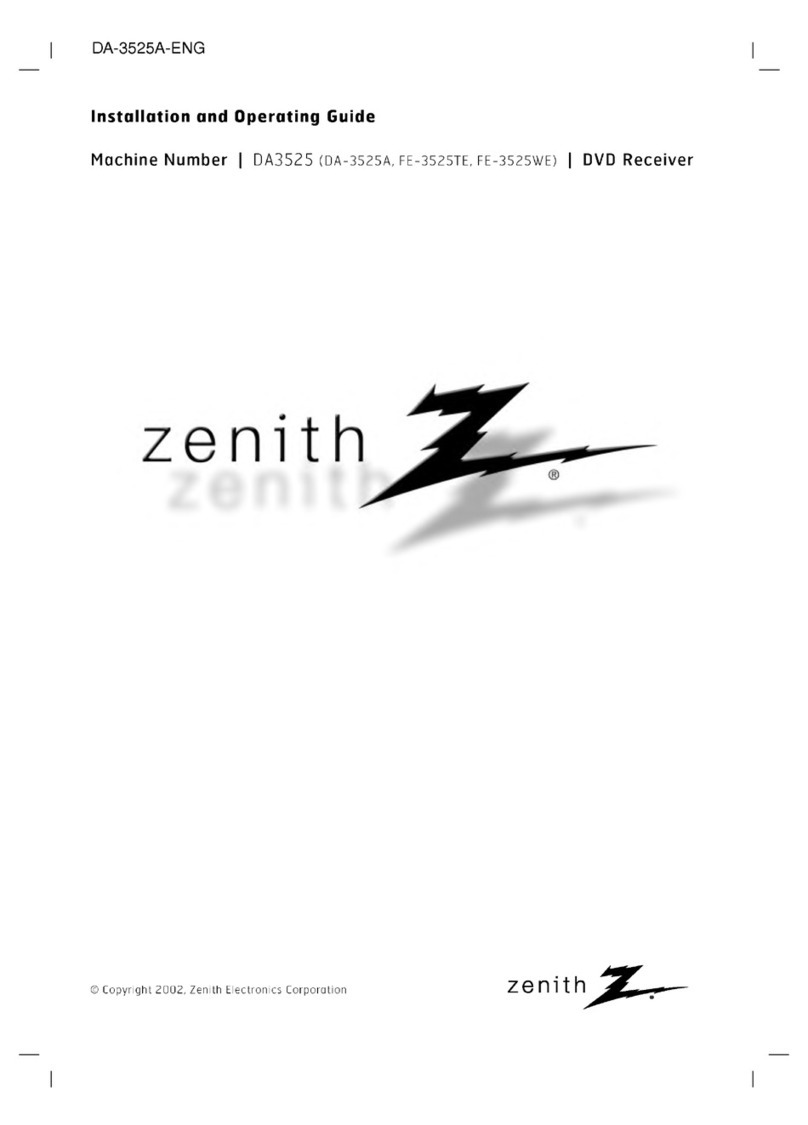
Zenith
Zenith Zenith Z Installation guide

Zenith
Zenith DVT316 Series User manual
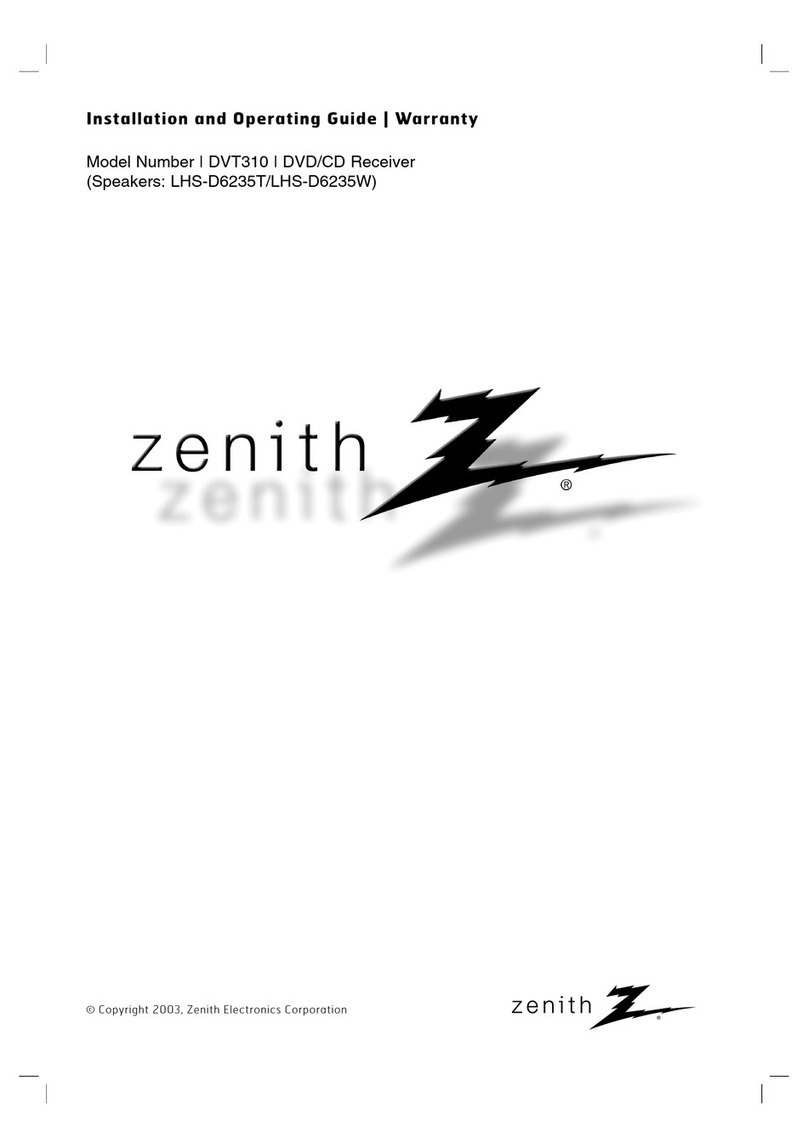
Zenith
Zenith DVT310 Installation guide
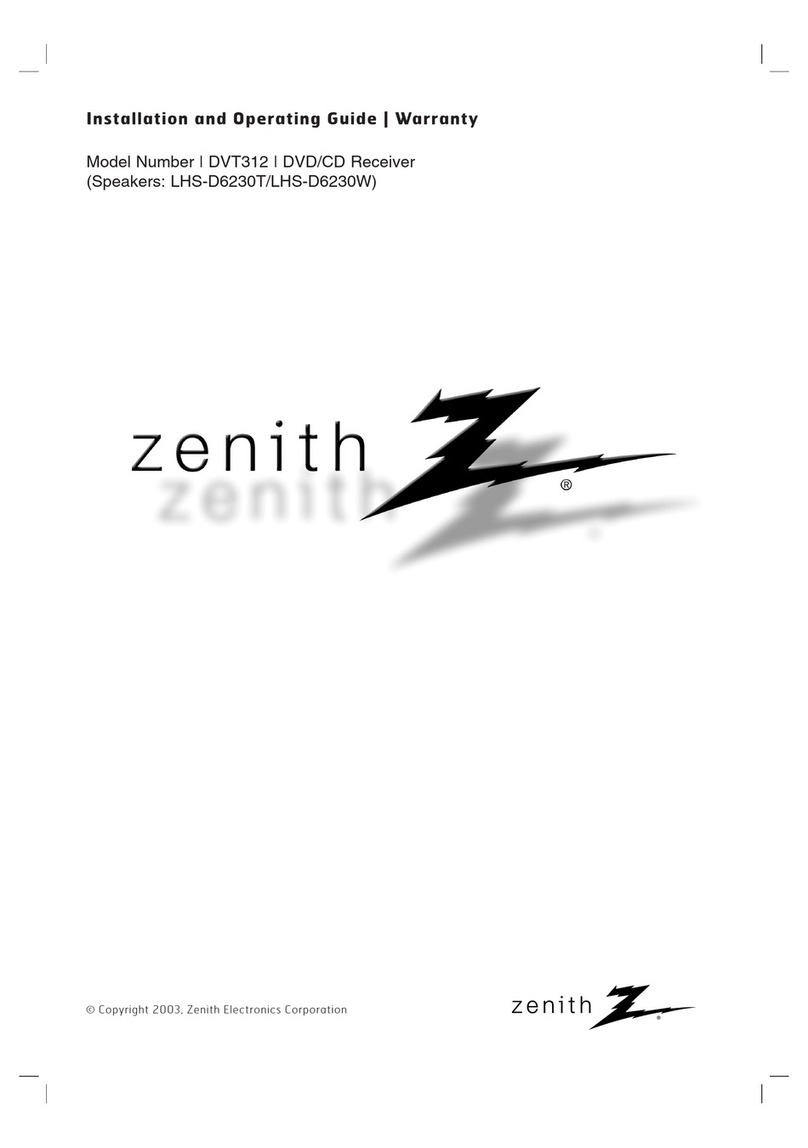
Zenith
Zenith DVT312 Installation guide
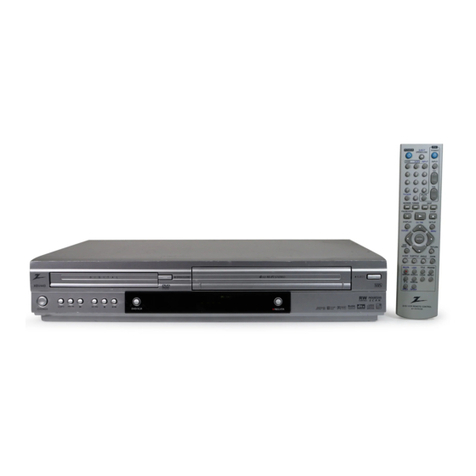
Zenith
Zenith XBV 443 User manual

Zenith
Zenith Royal 1000 User manual
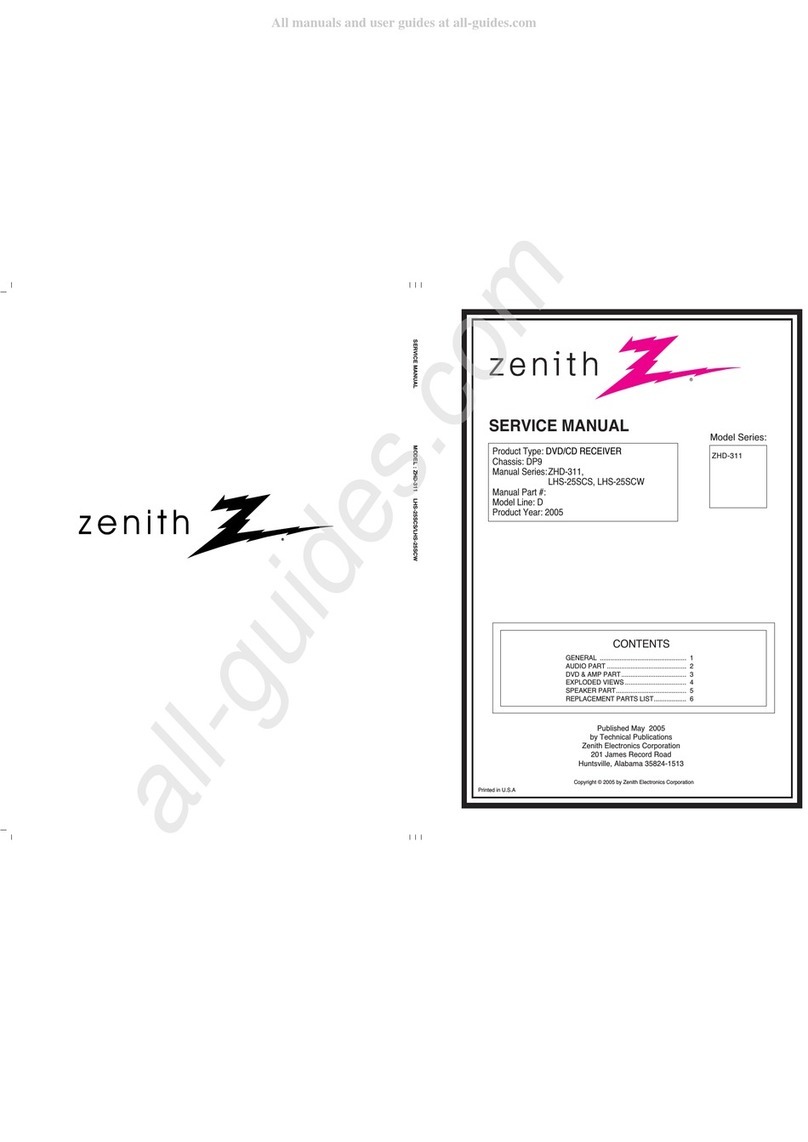
Zenith
Zenith ZHD-311 User manual

Zenith
Zenith 3235DT Troubleshooting guide

Zenith
Zenith 1937 User manual

Zenith
Zenith Royal 3000-1 User manual
